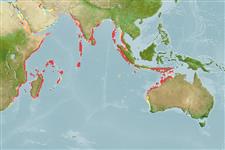Environment: milieu / climate zone / depth range / distribution range
Ökologie
seewasser riff-verbunden; standorttreu; tiefenbereich 3 - 30 m (Ref. 48391). Tropical
Eastern Indian Ocean: Sri Lanka to Western Australia, including Indonesia and the Andaman Is.
Size / Gewicht / Alter
Maturity: Lm ? range ? - ? cm
Max length : 15.0 cm TL Männchen/unbestimmt; (Ref. 4859)
Rückenflossenstacheln (insgesamt): 14; Rückenflossenweichstrahlen (insgesamt): 14-16; Afterflossenstacheln 3; Afterflossenweichstrahlen: 15 - 17.
Inhabits rocky areas of seaward reefs as well as rich coral areas (Ref. 9710). Feeds on algae; forms harems of 3-7 individuals. Frequently exported through the aquarium trade. Forms hybrids with Centropyge vrolikii in areas where these 2 species are sympatric, and hybrids with the C. flavissima have been recorded in the Christmas I. and Cocos-Keeling islands in the eastern Indian Ocean. Mimicked by the juveniles of the acanthurid Acanthurus tristis (Ref. 48391).
Life cycle and mating behavior
Geschlechtsreife | Fortpflanzung | Ablaichen | Eier | Fecundity | Larven
Pyle, R., 2001. Pomacanthidae: Angelfishes. p. 3266-3286. In K.E. Carpenter and V.H. Niem (eds.) FAO species identification guide for fishery purposes. The living marine resources of the Western Central Pacific. Volume 5. Bony fishes part 3 (Menidae to Pomacentridae). Rome, FAO. (Ref. 48391)
IUCN Rote Liste Status (Ref. 130435)
Bedrohung für Menschen
Harmless
Nutzung durch Menschen
Aquarium: Kommerziell
Mehr Information
NamenSynonymeMetabolismusRäuberÖkotoxikologieFortpflanzungGeschlechtsreifeAblaichenSpawning aggregationFecundityEierEientwicklung
ReferenzenAquakulturAquakultur ProfilZuchtlinienGenetikElectrophoresesVererbbarkeitKrankheitenVerarbeitungNutrientsMass conversion
PartnerBilderStamps, Coins Misc.LauteCiguateraGeschwindigkeitSchwimmstilKiemenoberflächeOtolithsGehirngrößeSehfähigkeit
Tools
Zusatzinformationen
Download XML
Internet Quellen
Estimates based on models
Preferred temperature (Ref.
123201): 25.2 - 29.3, mean 28.3 °C (based on 973 cells).
Phylogenetic diversity index (Ref.
82804): PD
50 = 0.5000 [Uniqueness, from 0.5 = low to 2.0 = high].
Bayesian length-weight: a=0.03090 (0.01359 - 0.07026), b=2.89 (2.70 - 3.08), in cm total length, based on LWR estimates for this (Sub)family-body shape (Ref.
93245).
Trophic level (Ref.
69278): 2.7 ±0.40 se; based on food items.
Widerstandsfähigkeit (Ref.
120179): mittel, Verdopplung der Population dauert 1,4 - 4,4 Jahre. (Preliminary K or Fecundity.).
Fishing Vulnerability (Ref.
59153): Low vulnerability (10 of 100).
Nutrients (Ref.
124155): Calcium = 82.9 [41.8, 130.9] mg/100g; Iron = 0.653 [0.403, 1.072] mg/100g; Protein = 18.2 [17.0, 19.3] %; Omega3 = 0.107 [0.066, 0.170] g/100g; Selenium = 24.3 [13.7, 44.6] μg/100g; VitaminA = 90 [24, 305] μg/100g; Zinc = 1.62 [1.12, 2.33] mg/100g (wet weight);
